Site pages
Current course
Participants
General
Module 1. Introduction to human engineering
Module 2. Human performance and responses
Module 3. Working environment and work space design
Module 4. Rehabilitation scheme and DMR Act
Topic 5
Topic 6
Topic 7
Topic 8
Topic 9
Topic 10
Lesson 10. ANTHROPOMETRY
M-III.10. ANTHROPOMETRY
10.1 Introduction
Anthropometry is the branch of the human science that deals with the data described by the size of human body measurements including body dimensions and the other physical characteristics and mechanical aspects of or the human body motions. Anthropometry is the technology of measuring various human traits as size, mobility and strength, whereas engineering anthropometry is the effort of the operator since human machine interface decides the ultimate performance of the equipment/work system. There is a large variation among body dimensions it is not economical or sometimes practically feasible to design the equipment/work places so as to suit 100% of the users. Therefore, generally the design is made in such a way so as to satisfy 90% of the users. This is achieved through use of 5th and 95th percentile limits. It means that those people who fall outside these limits will not be matched with respect to the criteria concerned. They will be able to use the equipment but may be with less efficiency and comfort. Anthropometric measurements are a critical element in equipment and workspace design. With the familiar with anthropometric data and its applications the work system, equipments, tools and jobs for proper fit to the human, to achieve safe and efficient operation. For example a tractor seat is designed, so the backrest, hand rest, seat cushion, seat width should be based on anthropometric data of farm workers.
10.1.1 Basic Ergonomics Design Principles:
a) Design for the average: The design of average is not fit for anyone. Because no one is average in all dimensions. These designs are utilized for design public facilities like public transport buses seats, roadside benches, these facilities are used by a large variety of peoples.
b) Design for the extremes: The extremes value may be large or very small for examples a tractor seat is designed for accommodate a range of persons, if the person is for heavy or the largest person or the smallest, so it may be not suitable for extremes.
c) Design for a range: it is the most common design philosophy and commonly used by the ergonomic to design arrange of population. A typical range of 5th and 95th percentile of population is used such a design would be expected to accommodate 90% of population.
10.2. Measurement of Anthropometric data:
There are very few studies available on anthropometric data on agricultural workers, again which are mainly case studies and involving only male workers. Therefore, a comprehensive data base involving 79 body dimensions and 16 strength parameters of at least 1000 agricultural workers (male : female :: 70% : 30%) as formulated by the ICAR is a major step towards future machinery design and development and also for modification in design of the existing machinery.
10.2.1. Equipments used for Measurement of Anthropometric Dimensions
a) Anthropometric equipment type A : It consists of a fixed pipe structure rigidly attached to a pentagonal base. Several lateral pipes are attached to the main pipe. All the steel pipes bear a linear metric scale so that measurement can be easily taken. The pipes can also rotate about their axis and locked in any position with the help of wing nuts.
b) Anthropometric equipment type B : It consists of several square section tubes which bear linear scale in centimeters. The tubular sections can be prolonged by sliding and inserting one end into the other. A veneer provision helps taking down various kinds of and difficult measurements. A span of 210 mm can be measured with this equipment. However, minimum distance measurable being only 0.6 cm (Fig.10.1).
c) Anthropometric seat/ chair : It consist of a number of angled iron which are arranged together to form a seat. The seat surface and the back one are made of plywood. The seat height is of 600 cm while the back being 100.0 cm & the width and length being 50.0 and 70.0 cm respectively. In accordance with the data requirement, the seat surface slides along the slots in the four legs of the seat for a distance of 24.0 cm vertically while horizontally it is 14 cm.
The seat surface board is fixed and fastened by tightening the four set of nuts and bolts. According to the comfort at the subject, the seat height is adjusted by loosening and then tightening the four set of bolts and nuts. This prepares the subject to undergo anthropometric test of data collection (Fig.10.1).
The equipments consisted of the following:
i) Anthropometer in canvass bag for measurement of length 0-960 mm on one side and 0-2100 mm on opposite side.
ii) Base plate for anthropometer.
iii) Re-curved measuring branches for anthropometer.
iv) Martin type sliding caliper used for measuring length up to 200 mm and depth up to 50 mm.
v) Spreading caliper with rounded ends having a measuring range of 0-600 mm.
vi) Skin fold caliper for measuring skin fold dimensions.
vii) Plastic tape of length of 2000 mm.
Grip cone
A truncated cone having a height of 27.8 cm was fabricated for measuring grip diameter (inside as well as outside). Its diameter range varied between 35-95 mm. Another cone of height 18.8 cm was fabricated for measuring middle figure–palm grip diameter. This cone has a measuring range of 10-40 mm.
Weighing balance
A spring type weighing balance having a least count of 0.5 kg and a range of 0-130 kg was used for measuring body weight of the subjects.
10.3. Procedure for measuring Anthropometric dimensions:
1) Isolate the equipments and prepare the subject.
2) Let the subject stand on the pentagonal platform of anthropometric equipment type A.
3) Measure the height, while standing, and while sitting in accordance with the instruments depicted in Fig.10.4 (a)
4) Note the dimensions where the equipment type A and then introduce equipment type B. (Fig.10.2) Vice-versa is also possible
5) Record each reading according to specifications
6) Put the subject into the anthropometric seat and take the dimensions as per the diagram Fig.10.4 (b).
7) Repeat similarly to different number of subjects
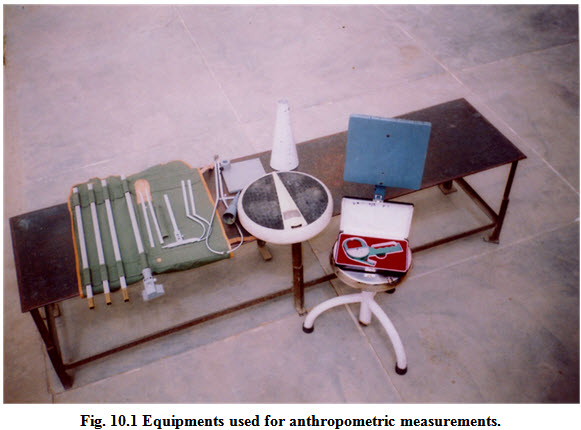


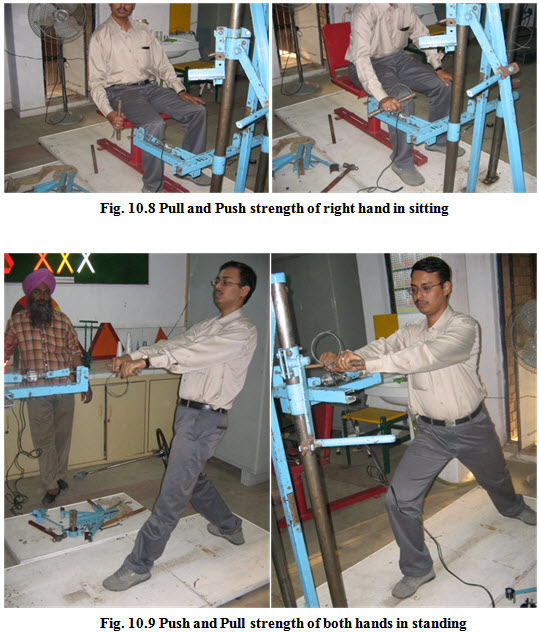

10.4. Analysis of Anthropometric Data:
Human being must not only fit spatially in a man task system, but must also be able to move in the work space. With the aid of anthropometric data we can provide an optimum work space layout, including good posture, contributing to considerable decrease in work load and an improvement in the performance. Normally, during collection of human engineering data skip the first and last five percentile. Thus while designing a seat; it should be designed to accommodate a reasonable range of individuals, usually from 5th to 95th percentiles. Seat should be designed to take maximum weight expected. In order to realize a good performance, it is necessary that the movements of the body members are in synchrony, simple and logical motions are made, which can be performed almost automatically by the central nervous system. Lower percentile values of seat height and seat depth should be taken.
For Indian agricultural workers including male and female workers, the stature would vary from 1350 mm to 1830 mm, thus the range would be 1830-1350=480 mm. according to the formula given by Raghavrao (1983), the standard deviation can be estimated from range as follows:
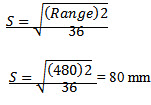
It is defined as the ratio of weight of a person to his /her height squared (Keys, 1972)

Measures of central tendency (mean) and dispersion (standard deviation) are good descriptive statistics of the distribution of the mass of data. Beside these two, there are two other characteristics of the distribution. These are Asymmetry also known as skewness (β) and Kurtosis or Peakedness (β2).
The skewness (β1):

For normal distribution, the value of β1 as well as β2 would be 0 to give the idea of distribution of mass data for different dimensions; the values of β1 and β2 have been calculated and given in here.
Table. 10.1 Anthropometric dimensions of agricultural workers
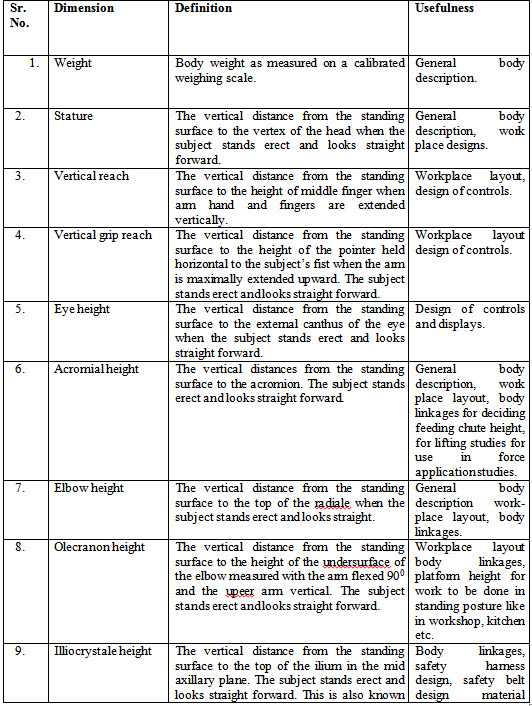


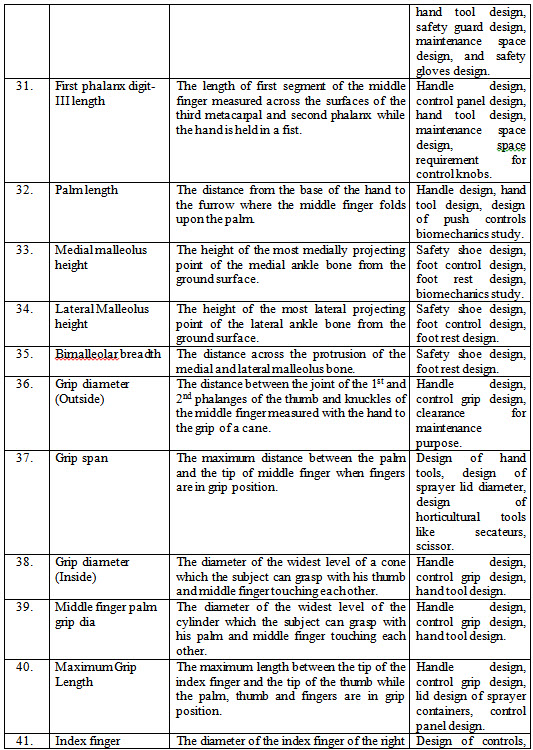
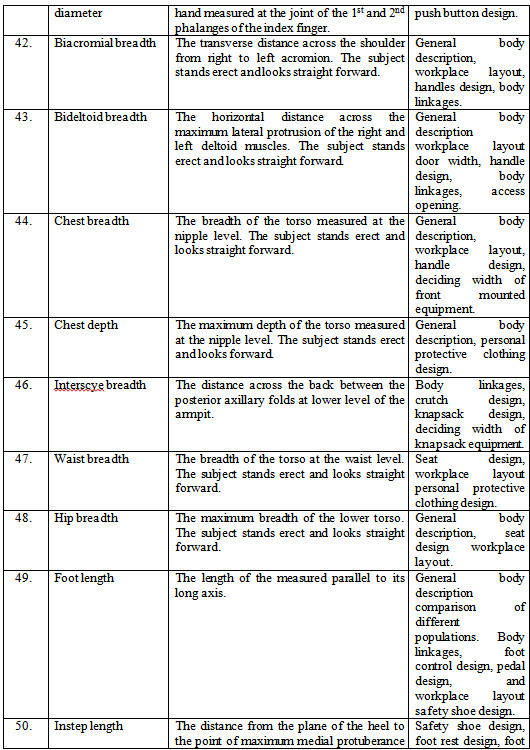
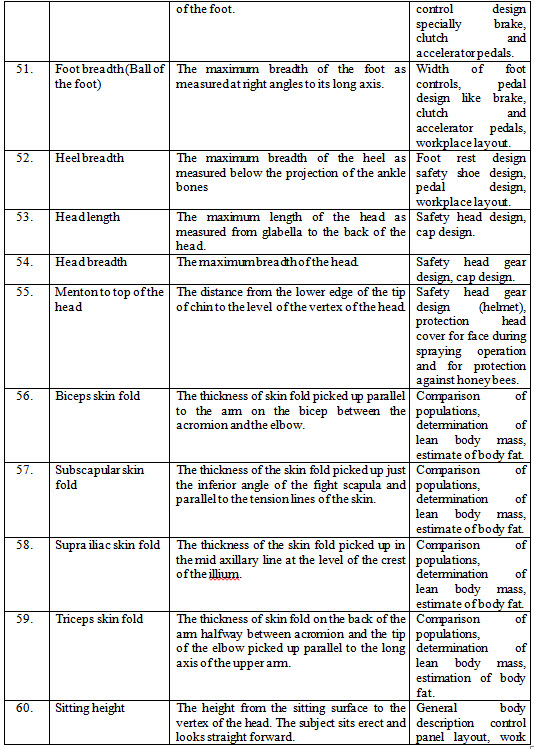
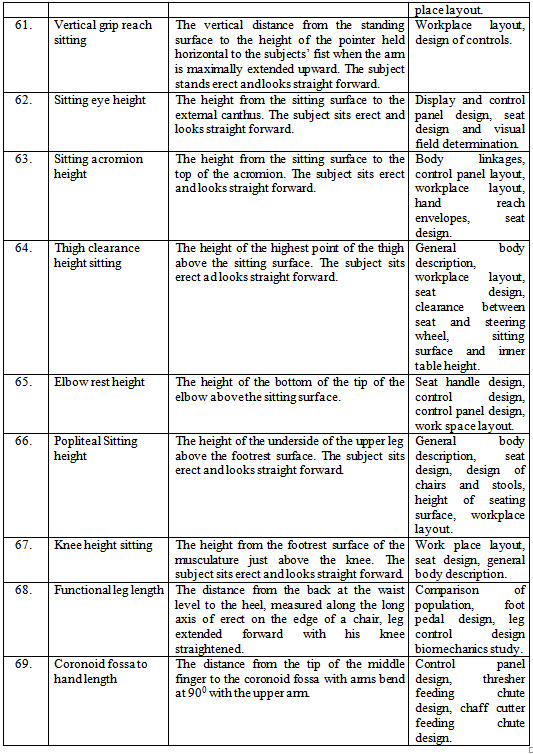

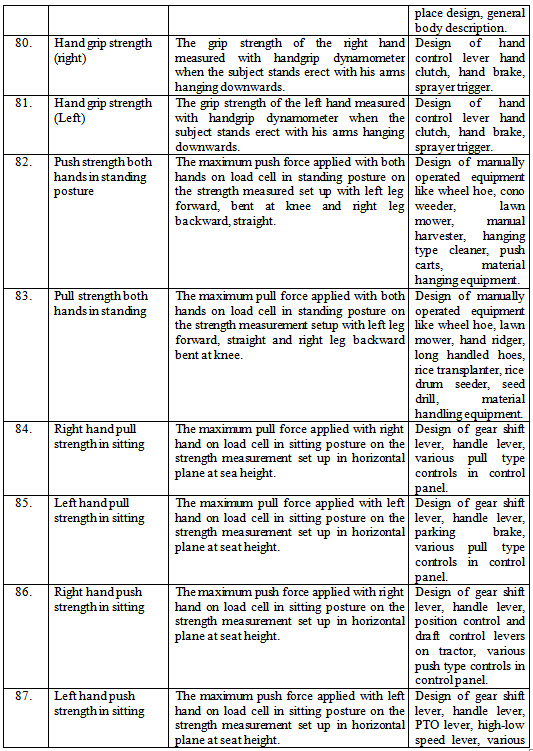


Roebuck et al. (1975) quoted to design engineering anthropometry. It is concerned with the physical measurements of human body required mainly to develop the basic engineering standards, set specific requirements and desire suitability of any manufactured product intended for the human consumer. Gite et al. (2009) collected anthropometric data of agricultural workers and compiled the data on all India, Arunachal Pradesh, Gujarat, Jammu & Kashmir, Madhya Pradesh, Maharashtra, Meghalaya, Mizoram, Orissa, Punjab, Tamil Nadu, Uttar Pradesh and West Bengal. They suggested the use of data for design of farm machinery on the basis of 5th, 50th and 95th percentile values of the dimensions (Table.10.2).
Table. 10.2 Mean anthropometric and strength data of Male and Female Indian Agricultural Workers
|
|
|
Male |
|
|
Female |
|
|
|
95th |
Mean |
5th |
95th |
Mean |
5th |
|
Weight (Kg) |
68.9 |
54.7 |
40.4 |
59.1 |
46.3 |
33.55 |
|
Stature |
1774 |
1633 |
1521 |
1615 |
1515 |
1414 |
|
Acromial height |
1468 |
1362 |
1248 |
1353 |
1261 |
1196 |
|
Arm reach from the wall |
921 |
838 |
756 |
848 |
773 |
681 |
|
Bi-acromial breadth |
402 |
330 |
364 |
340 |
292 |
243 |
|
Bideltoid breadth |
471 |
416 |
361 |
423 |
371 |
318 |
|
Calf circumference |
367 |
312 |
310 |
353 |
292 |
230 |
|
Chest circumference |
944 |
845 |
746 |
934 |
813 |
693 |
|
Chest depth |
243 |
208 |
173 |
259 |
207 |
154 |
|
Coronoid fossa to hand length |
439 |
392 |
345 |
400 |
357 |
314 |
|
Elbow- elbow breadth sitting |
452 |
375 |
297 |
413 |
350 |
286 |
|
Elbow height |
1115 |
1027 |
938 |
1037 |
960 |
883 |
|
Elbow rest height |
266 |
214 |
162 |
259 |
208 |
158 |
|
Eye height |
1636 |
1522 |
1409 |
1504 |
1403 |
1302 |
|
Foot breadth (ball of foot) |
110 |
94 |
78 |
101 |
89 |
76 |
|
Foot length |
269 |
245 |
221 |
243 |
227 |
212 |
|
Forearm hand length |
503 |
453 |
408 |
462 |
417 |
378 |
|
Hand length |
197 |
178 |
160 |
182 |
167 |
151 |
|
Head breadth |
171 |
148 |
125 |
202 |
142 |
156 |
|
head length |
205 |
185 |
166 |
202 |
179 |
156 |
|
Hip breadth sitting |
364 |
311 |
258 |
355 |
302 |
249 |
|
Instep length |
208 |
184 |
142 |
191 |
167 |
149 |
|
Knee height |
530 |
472 |
415 |
488 |
438 |
388 |
|
Medial malleous height |
96 |
80 |
63 |
92 |
74 |
56 |
|
Menton to top of the head |
246 |
213 |
179 |
232 |
197 |
162 |
|
Metacarpal-III height |
763 |
690 |
616 |
718 |
649 |
581 |
|
Olecranon height |
1085 |
999 |
913 |
1011 |
936 |
861 |
|
Popliteal height sitting |
468 |
417 |
367 |
441 |
391 |
342 |
|
Sitting Acromial height |
645 |
568 |
492 |
597 |
529 |
461 |
|
Sitting eye height |
812 |
726 |
640 |
743 |
771 |
599 |
|
Sitting height |
916 |
830 |
744 |
847 |
775 |
702 |
|
Span |
1832 |
1697 |
1562 |
1680 |
1551 |
1422 |
|
Span Akimbo |
964 |
872 |
780 |
872 |
790 |
707 |
|
Trochanteric height |
925 |
814 |
703 |
842 |
777 |
695 |
|
Vertical reach |
2237 |
2080 |
1923 |
2063 |
1921 |
1778 |
|
Waist back length |
510 |
443 |
375 |
447 |
385 |
367 |
|
Waist circumference |
901 |
765 |
629 |
858 |
720 |
582 |
(Source:Gite, 2009)
References:
Gite LP. 2009. Anthropometric and strength data of Indian Agricultural Workers for farm equipment design. AICRP on ESA. CIAE, Bhopal.